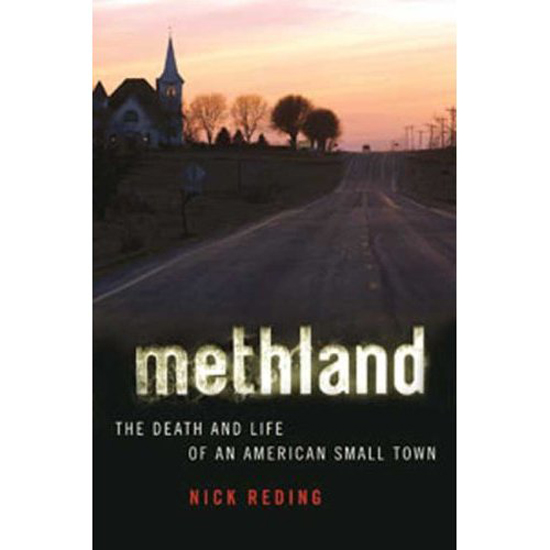
Like other psychoactive drugs, methamphetamine provides a powerful form of escape from what may be a grim reality, acting on our neurotransmitters to make us feel happy, even euphoric. Long overlooked by the media and a law enforcement community preoccupied with fighting the “war” on crack cocaine, and stereotyped as the drug of bikers, truckers, and blue-collar workers, it finally grabbed headlines in the middle of this decade amid evidence of a meth epidemic in the United States. Congress passed the Combat Meth Act in 2006, cracking down on distribution of pseudoephedrine, a precursor chemical for meth production, and the George W. Bush administration’s drug czar confidently declared that the United States was winning the “war” on meth.
But as journalist Nick Reding graphically shows in Methland: The Death and Life of an American Small Town, an exhaustive study of the meth epidemic in the United States, the drug has sunk deep roots, particularly in the rural heartland of the nation, where it has moved into the vacuum left by the decline of the farm economy, shredding the social fabric of communities from Iowa to Idaho. The “real story” of meth, Reding says, “is as much about the death of a way of life as it is about the birth of a drug.”
Reding’s first book, The Last Cowboys at the End of the World, explored the fading rural culture of Chilean gauchos. In Methland, he zooms in on one particular small town — Oelwein, Iowa (population: 6,700) — as a “metaphor for all of rural America and its problems.” There, as elsewhere, he says, the meth epidemic has evolved “in lockstep” with the rise of Big Pharmaceuticals, Big Agriculture, and the major Mexican drug trafficking organizations (DTOs), which have, to a large extent, taken over meth production from “Beavis and Butthead” producers cooking up meth in their bathtubs.
In Oelwein, Reding views the meth epidemic through the eyes of several citizens, including a doctor, a prosecutor, the mayor, and the police chief, who are all battling in their own way for the town’s survival. Mayor Larry Murphy, for example, embarks on an ambitious economic redevelopment initiative, while Chief Jeremy Logan cracks down on local meth cooks. But Reding’s encounters with long-term local addict Roland Jarvis, who burned off his much of his skin when the meth lab in his home exploded, are the most haunting.
“At thirty-eight, Jarvis had become a sort of poster boy around Oelwein for the horrific consequences of long-term meth addiction,” he writes. “… He was always cold, he said, and hadn’t slept more than three hours at a time in years. His skin was still covered in open, pussing sores. He had no job and no hope of getting one.” Through Jarvis and another woebegone addict named Major in nearby Independence, Iowa, Reding suggests that meth is not so much a form of escape, but of imprisonment. “[W]ithout meth, Major found it impossible to feel, as he put it, ‘happy,’” he observes.
Other notable characters include Lori Arnold, the sister of comedian Tom Arnold and at one time a major meth dealer in her home state of Iowa. Arnold’s original suppliers were a pair of Mexican brothers in Southern California and, after getting a job at a meatpacking plant in Ottumwa, Iowa, she used illegal immigrants from Mexico to distribute meth supplied by the DTOs. In the illegals, Reding observes, the DTOs “had a built-in retail and distribution system that, because it is so hard to track, is all but impenetrable by law enforcement.”
Reding also finesses his way out of trouble when, in a chilling scene, he is confronted in an Oelwein bar by a paranoid meth user who suspects him of being a narc. “He said he’d be honest with me: he hated DEA [Drug Enforcement Administration],” he says. “Nor, he said, would it be any skin off his teeth to make sure I never came back to town again.”
Ultimately, Oelwein — which Jay Leno once called “possibly the worst place in the world” — is the key character in Methland, the resourcefulness of its inhabitants in the face of the meth scourge a tribute to the human spirit. Reding is less effective when he pans away from the town and discusses the macroeconomic forces behind the meth epidemic. He gets tangled up in the theories of post-Cold War thinkers Thomas P.M. Barnett and Moisés Naím, and indulges in a rather aimless detour to Algona, Iowa, simply because his father grew up there. “Earmarks” and “pork barrel spending,” he says at one point, are catchphrases that express the “depth and unhealthiness of the relationship between the federal government and major corporations” — when they are usually associated with the unhealthy relationship between lawmakers and their constituents.
But by the end of the book, Reding has circled back to Oelwein and makes it very clear that no matter what Bush drug czar John Walters said, the war on meth is not being won. “[C]learly there was still a lot of meth around town,” he says in describing his last visit to Oelwein, reporting that prosecutor Nathan Lein has not noticed a drop in meth-related cases. Local meth production may have fallen, but when asked what he’d do about the DTOs, Police Chief Logan replies, “Who knows?” As for the Combat Meth Act, Reding says, Congress made it “more of a guideline than an actual mandate, leaving specific interpretation to national governments.”
“Meth truly will never go away,” a former DEA agent tells Reding. “It can’t. It’s too big a piece of what we are.”
- Follow us on Twitter: @inthefray
- Comment on stories or like us on Facebook
- Subscribe to our free email newsletter
- Send us your writing, photography, or artwork
- Republish our Creative Commons-licensed content

